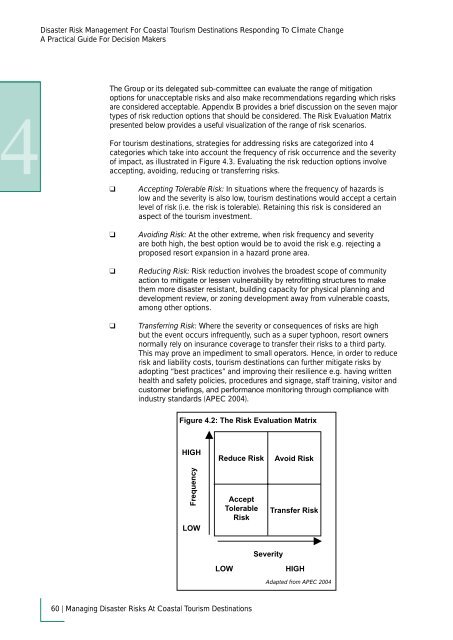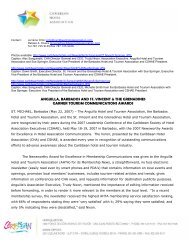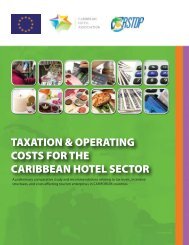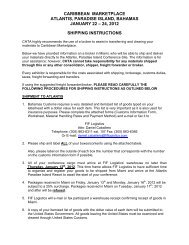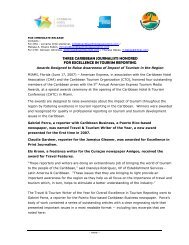Disaster Risk Management for Coastal Tourism - Caribbean Hotel ...
Disaster Risk Management for Coastal Tourism - Caribbean Hotel ...
Disaster Risk Management for Coastal Tourism - Caribbean Hotel ...
You also want an ePaper? Increase the reach of your titles
YUMPU automatically turns print PDFs into web optimized ePapers that Google loves.
<strong>Disaster</strong> <strong>Risk</strong> <strong>Management</strong> For <strong>Coastal</strong> <strong>Tourism</strong> Destinations Responding To Climate Change<br />
A Practical Guide For Decision Makers<br />
The Group or its delegated sub-committee can evaluate the range of mitigation<br />
options <strong>for</strong> unacceptable risks and also make recommendations regarding which risks<br />
are considered acceptable. Appendix B provides a brief discussion on the seven major<br />
types of risk reduction options that should be considered. The <strong>Risk</strong> Evaluation Matrix<br />
presented below provides a useful visualization of the range of risk scenarios.<br />
For tourism destinations, strategies <strong>for</strong> addressing risks are categorized into 4<br />
categories which take into account the frequency of risk occurrence and the severity<br />
of impact, as illustrated in Figure 4.3. Evaluating the risk reduction options involve<br />
accepting, avoiding, reducing or transferring risks.<br />
<br />
<br />
<br />
<br />
Accepting Tolerable <strong>Risk</strong>: In situations where the frequency of hazards is<br />
low and the severity is also low, tourism destinations would accept a certain<br />
level of risk (i.e. the risk is tolerable). Retaining this risk is considered an<br />
aspect of the tourism investment.<br />
Avoiding <strong>Risk</strong>: At the other extreme, when risk frequency and severity<br />
are both high, the best option would be to avoid the risk e.g. rejecting a<br />
proposed resort expansion in a hazard prone area.<br />
Reducing <strong>Risk</strong>: <strong>Risk</strong> reduction involves the broadest scope of community<br />
<br />
them more disaster resistant, building capacity <strong>for</strong> physical planning and<br />
development review, or zoning development away from vulnerable coasts,<br />
among other options.<br />
Transferring <strong>Risk</strong>: Where the severity or consequences of risks are high<br />
but the event occurs infrequently, such as a super typhoon, resort owners<br />
normally rely on insurance coverage to transfer their risks to a third party.<br />
This may prove an impediment to small operators. Hence, in order to reduce<br />
risk and liability costs, tourism destinations can further mitigate risks by<br />
adopting “best practices” and improving their resilience e.g. having written<br />
health and safety policies, procedures and signage, staff training, visitor and<br />
<br />
industry standards (APEC 2004).<br />
Figure 4.2: The <strong>Risk</strong> Evaluation Matrix<br />
HIGH<br />
Frequency<br />
LOW<br />
Reduce <strong>Risk</strong><br />
Accept<br />
Tolerable<br />
<strong>Risk</strong><br />
Avoid <strong>Risk</strong><br />
Transfer <strong>Risk</strong><br />
Severity<br />
LOW<br />
HIGH<br />
Adapted from APEC 2004<br />
60 | Managing <strong>Disaster</strong> <strong>Risk</strong>s At <strong>Coastal</strong> <strong>Tourism</strong> Destinations


